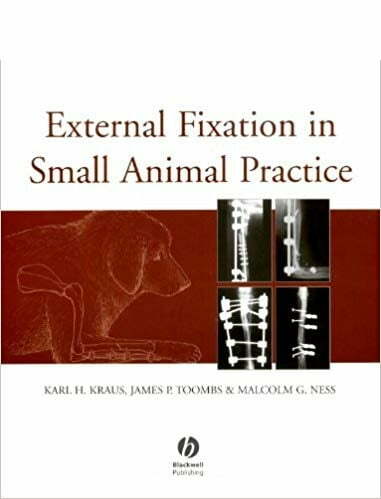External Fixation in Small Animal Practice
by Karl H. Kraus in March, 2003
External fixation is one of the most versatile treatment options for fracture repair in small animals. The advantages
 include enhancing both the mechanical and biologic environment for optimal fracture healing. Veterinary external fixation is evolving and there are now improved techniques, better instrumentation and a continuing reduction in the incidence of complications. General veterinary practitioners can master the techniques and equipment costs are low.
include enhancing both the mechanical and biologic environment for optimal fracture healing. Veterinary external fixation is evolving and there are now improved techniques, better instrumentation and a continuing reduction in the incidence of complications. General veterinary practitioners can master the techniques and equipment costs are low.
This book offers a highly practical guide to the use of linear external fixators in small animal practice. Divided into two sections, the first section reviews essential knowledge and technical details that underpin the successful treatment of a clinical case. The second is a collection of case studies selected to show the range of fracture types and fixator systems available. Within each case there is discussion of treatment options and clinical decision-making. Follow-up radiographs then provide invaluable insight into the normal radiographic appearance of healing and healed fractures.
The authors have put together an intensely practical book that will no doubt prove to be the perfect learning tool for the surgical resident and practising veterinarian.
Key features:
- A unique approach ensures the book is both practical and easy to read
- Written to appeal to practising veterinarians world-wide
- Contains over three hundred high quality radiographs
This book is a practical guide to the use of linear external fixators for the management of fractures in small animals. Divided into two parts, part I is a detailed review of the essential knowledge and technical detail that underpin the successful treatment of a clinical case. Much accumulated experience with veterinary external fixation was gained using the Kirschner-Ehmer (K-E) type of fixator systems, but recent years have seen the introduction of several second-generation veterinary fixator systems that address some limitations inherent in the K-E design and, at the same time, permit the surgeon to manipulate the fixator to respond to the varying biomechanical needs of a healing fracture. Three of these second-generation systems are described in detail – the Securos system, the IMEX-SK system, and the acrylic pin external fixation (APEF) system.
| PDF Size: 13 MB | Book Download Free |
Password: pdflibrary.net
Password: pdflibrary.net
